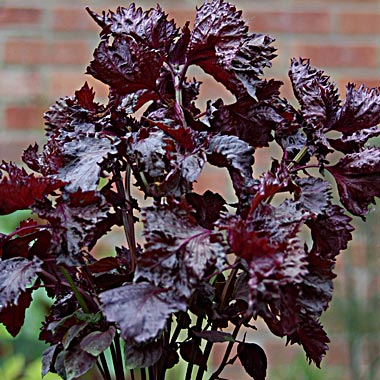


Purple Shiso - Perilla
Perilla frutescens 'Crispa rubra'
Delivery May onward (weather dependant).

Shiso can be planted outside in late spring, once the danger of frost has passed.
It is similar in appearance to a tall purple coleus.
The leaves are strongly scented and are reminiscent of cumin in flavour,
the flavour increases in strength as the plant grows larger.
It can grow quite tall in a warm sheltered position and it is a good thing to pinch out the tip of the plant at about 60cm,
so that it bushes out.
It makes a fine specimen plant in the centre of containers, or within planting schemes in the flower borders.
Both the leaves and flowers can be eaten.
The leaves are used as wraps in Japanese cuisine in a similar way to vine leaves in Greece,
and they are given various fillings generally based on rice, chicken or pork.
The leaves can also be used raw in salads and with raw fish, bean curd and dipped in batter to be cooked as tempura.
The flowers make a pretty edible decoration to any dish.
Shiso leaves stuffed with rice and pinenuts.
- 10 large shiso leaves
- 25g butter
- 1 onion – very finely chopped
- 3 tbls chives or lovage – chopped
- 125g cooled, cooked rice
- 1 beaten egg
- seasoning
- 40g pine nuts
Method:
- Dip each leaf into boiling water and lay out flat to cool.
- Fry the onion in butter until very soft but not brown.
- Stir in the rest of the ingredients and mix gently, season to taste.
- Place a teaspoon of the mixture into the centre of each leaf and roll up like a cigar, tucking in the ends as you go.
- Arrange on a pretty serving dish and chill until required.
- Serve garnished with chopped shiso leaves, or flowers if available, and a vinaigrette dressing.
The deep purple colour from the leaves can be used as a natural colouring when preserving fruit.
As you can see this is a herb which is ready for lots of culinary experimentation!